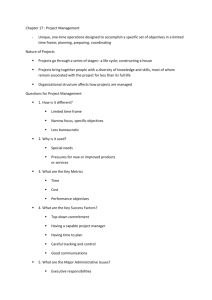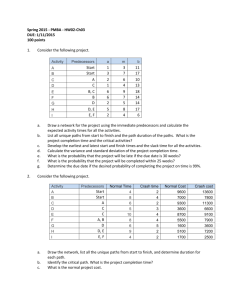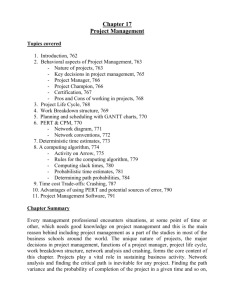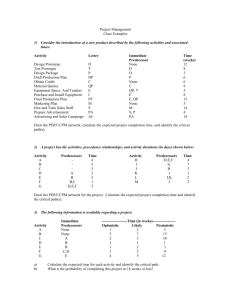Project Evaluation and Review Technique (PERT)
advertisement
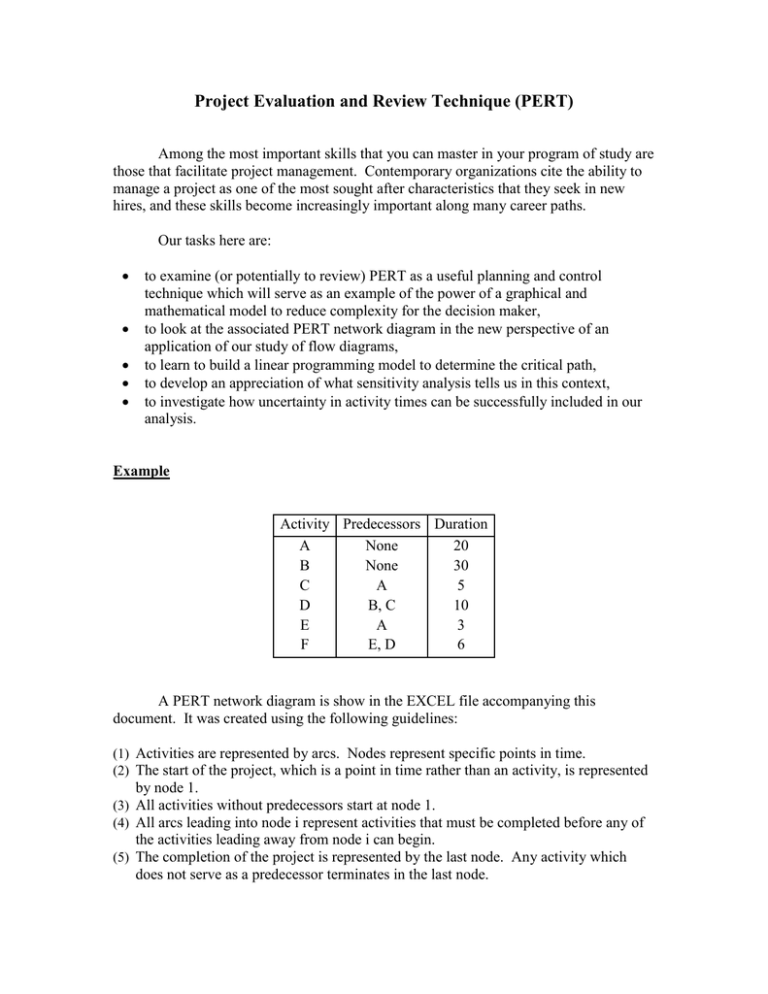
Project Evaluation and Review Technique (PERT) Among the most important skills that you can master in your program of study are those that facilitate project management. Contemporary organizations cite the ability to manage a project as one of the most sought after characteristics that they seek in new hires, and these skills become increasingly important along many career paths. Our tasks here are: to examine (or potentially to review) PERT as a useful planning and control technique which will serve as an example of the power of a graphical and mathematical model to reduce complexity for the decision maker, to look at the associated PERT network diagram in the new perspective of an application of our study of flow diagrams, to learn to build a linear programming model to determine the critical path, to develop an appreciation of what sensitivity analysis tells us in this context, to investigate how uncertainty in activity times can be successfully included in our analysis. Example Activity Predecessors Duration A None 20 B None 30 C A 5 D B, C 10 E A 3 F E, D 6 A PERT network diagram is show in the EXCEL file accompanying this document. It was created using the following guidelines: (1) Activities are represented by arcs. Nodes represent specific points in time. (2) The start of the project, which is a point in time rather than an activity, is represented by node 1. (3) All activities without predecessors start at node 1. (4) All arcs leading into node i represent activities that must be completed before any of the activities leading away from node i can begin. (5) The completion of the project is represented by the last node. Any activity which does not serve as a predecessor terminates in the last node. (6) And one technical detail: the arc between two nodes must be unique. If two or more activities could start at node i and end at node j, then it is necessary to establish a dummy activity which requires 0 amount of time to accomplish. To illustrate, suppose we have the portion of a network diagram as shown below. E:8 3 5 F:5 We augment the diagram as follows: E:8 3 4 d:0 F:5 5 Determining the Critical Path 2 E:3 A:20 1 4 C:5 5 F:6 B:30 D:10 3 Collecting this information into a table gives us: Activity Earliest Finish Latest Finish A 20 25 B 30 30 C 25 30 D 40 40 E 23 40 F 46 46 Slack 5 0 5 0 17 0 Our analysis shows that activity A can be delayed up to 5 days without delaying the overall project. On the other hand, any delay in activities B, D, and F will cause an overall delay in the completion of the project. These activities form a path through the network, referred to as the critical path. What is the characteristic of this path that makes it unique relative to other paths through the network? A Linear Programming Approach Linear programming can also be used to determine the project duration and critical path. Consider the model in the worksheet entitled A Linear Program. The idea is this: Let x1 and x2 represent the start times for activities emanating from nodes 1 and 2, respectively. Then we have to be able to perform activity A between these two times: 𝑥2 − 𝑥1 ≥ 20 We will have one constraint like this for each activity. How can we detect what the critical path is from the linear programming model? Can sensitivity analysis help us distinguish which path(s) are critical? Notice that if there are multiple critical paths, then the non-zero shadow prices will not fall on a unique path. This could greatly complicate the management of the project! Crashing the Project Of course, the whole point of determining the critical path is to identify those activities which deserve highest priority from a management point of view. It may happen that the project must be completed faster than the length of the critical path. The only way this can happen is if more resources are applied to complete selected activities faster. The process of reducing the duration of the project is referred to as crashing the project. If we wanted to reduce the project by 1 day, which activities should we consider? How do we choose among them? The table below gives estimates of the cost of reducing each activity and the maximum number of days that each activity can be shortened. Activity A B C D E F Cost/day of reduction 180 250 200 450 220 480 Maximum reduction 3 6 5 2 4 2 Which activity would you crash? Why? How long can we do this? Can anything go wrong? When we build a model of this problem, what should our objective be? In our linear program, recall that we had the inequality 𝑥2 − 𝑥1 ≥ 20 If rA represents the amount we crash activity A, our inequality becomes 𝑥2 − 𝑥1 ≥ 20 − 𝑟𝐴 Writing this in the form where all of the variables are on the LHS, 𝑥2 − 𝑥1 + 𝑟𝐴 ≥ 20 There will be one constraint like this for each activity. We have another constraint on rA: 𝑟𝐴 ≤ 3 There will be one constraint of this form for each activity. Now if we want to crash our project to, say, 39 days, we add the constraint 𝑥5 ≤ 39 See the sheet entitled Crashing. A sensitivity report is provided in the sheet Crashing Sensitivity. Homework The following information describes a proposed construction project. Activity Predecessors Duration A B C D E F G H None None A A B D, E D,E C, F 5 3 7 6 7 3 10 8 Crash Maximum Cost/day Crash 1200 1000 800 1400 1200 1500 1100 1500 1 1 1 1 1 2 1 2 (a) Construct a PERT network diagram for this project. (b) Identify the critical path and its length. (c) Construct a linear programming model to determine the project duration and the critical path. (d) Construct a linear programming model to determine the optimal crashing of the project for 2 days and for 3 days.
